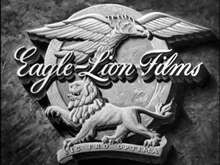Eagle-Lion Films
 | |
 | |
| Industry | Film studio |
|---|---|
| Founded | Sept 1946 |
| Defunct | 1950 |
| Fate | Merger |
| Successor | Eagle-Lion Classics |
Key people | J. Arthur Rank |
Eagle-Lion Films was a British-American film production company owned by J. Arthur Rank intended to release British productions in the United States.
In 1947 it acquired Robert R. Young's PRC Pictures, a small American production company, to produce B Pictures to accompany the British releases. The studio became one of the most respected makers of B-movies on what was known as Hollywood's "Poverty Row."
Eagle-Lion was also a film distribution company under the name of Eagle-Lion Distributors Limited in the United Kingdom and Eagle-Lion Films Inc. in the United States. In 1954, the film lot, at 7324 Santa Monica Boulevard, was purchased by the Ziv Company for production of its syndicated television programs.[1] It has long since been demolished.
History[]
The company was founded in September 1946.
From 1946 to 1949, Eagle-Lion was under the control of Arthur B. Krim who, in addition to releasing films by Rank and reissues of David O. Selznick, films produced his own B-movies as support. Bryan Foy the former head of the B-picture unit at Warner Bros., was placed in charge of production.[2] Some of the producers working at Eagle-Lion included Aubrey Schenck, Jack Schwarz and briefly, Walter Wanger and George Pal. Directors included Anthony Mann.
The initial arrangement was that Rank and Eagle-Lion would each produce five films a year. Costs were initially kept to less than $500,000 per film. Their first year of films were financed with $8 million in loans from the Bank of America which Young personally guaranteed.[3]
The company recorded a loss of $2.2 million in 1947. Krim later attributed this to them paying too much money for stars who were scarcely good enough to prevent insufficient box-office returns.[4] This encouraged Eagle-Lion to change its mode of production, using more independent producers as a source for new films. Bryan Foy resigned as head of production to become an independent producer for the company and Arthur Krim became studio chief. Eagle-Lion would help finance the films and offer facilities, although producers would find their own money too. Along with Foy, other independent producers who worked for Eagle-Lion included Edward Small, Walter Wanger and George Pal. They began making lower-budgeted films, enjoying particular success with film noir.
Eagle-Lion had acquired the film studio of Producers Releasing Corporation (PRC) which had acquired the building from Grand National Pictures which ceased operations in 1939. PRC was dissolved in August 1947 and its product was shifted to Eagle-Lion.
By 1947–48, the studio had accomplished 14 productions. By the spring of 1949, ten were in release, five of which earned a substantial profit – T-Men, Raw Deal, Canon City, He Walked By Night and The Noose Hangs High. Two others broke even and two others showed losses. If the company had completely financed these films it would have made $1.2 million but as it was it made $200,000.[5] However, because of its unsuccessful first year, the company still owed money and closed its studio in November 1948.
Eagle-Lion released a series of British films, most of which were unsuccessful at the American box office. There were some exceptions, such as The Red Shoes which earned rentals of $5 million[6][7] as well as being their only release which was nominated for the Academy Award for Best Picture.
The company suffered increasing financial difficulties throughout 1949. Krim resigned in May and the company ceased production at the end of the year. Eagle-Lion merged with Film Classics in 1950 to become Eagle-Lion Classics.
Assistant director Reggie Callow felt that the studio would have survived longer had they kept producing low-budget films rather than attempting to compete with the major studios by making higher-budgeted films.[8]
In 1951, Krim was offered the leadership of United Artists. In April of that year, UA took over distribution of Eagle-Lion's current releases; Eagle-Lion terminated the releasing pact with Rank and ceased distributing movies. Their studios were sold.[9]
In 1954, Frederick Ziv bought the studio for his Ziv Television Programs.
Filmography[]
Notes[]
- ^ "Profiles of First-Place Winners". Billboard. 12 February 1955. p. 10. Retrieved 11 January 2017.
- ^ p.87 Mirisch, Walter I Thought We Were Making Movies, Not History Univ of Wisconsin Press, 27 February 2008
- ^ p. 21 Balio, Tino United Artists: The Company That Changed the Film Industry Univ of Wisconsin Press, 1987
- ^ Balio p 24
- ^ Balio p 31
- ^ "All Time Domestic Champs". Variety. 6 January 1960. p. 34.
- ^ Balio p 34
- ^ p.63 Callow, Ridgeway & Behlmer, Rudy Shoot the Rehearsal!: Behind the Scenes With Assistant Director Reggie Callow Scarecrow Press, 1 June 2010
- ^ Balio p. 37
External links[]
- Eagle-Lion Films at IMDb 1947–1950
- Eagle-Lion Films at IMDb 1950–1951
- UK Eagle-Lion Eagle-Lion Films at IMDb
- Eagle-Lion Films films
- British film studios
- Defunct American film studios
- Defunct film and television production companies of the United States
- Film production companies of the United Kingdom
- Film production companies of the United States
- Film distributors of the United Kingdom
- Film distributors of the United States
- Entertainment companies based in California
- American companies established in 1946
- British companies established in 1946
- Entertainment companies established in 1946
- Mass media companies established in 1946
- Mass media companies disestablished in 1950
- 1946 establishments in England
- 1950 disestablishments in England
- 1946 establishments in California
- 1950 disestablishments in California
- Defunct companies based in Greater Los Angeles
- Defunct companies based in London
- British companies disestablished in 1950

